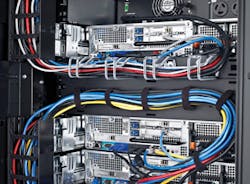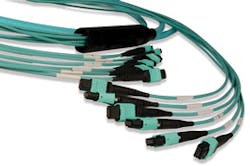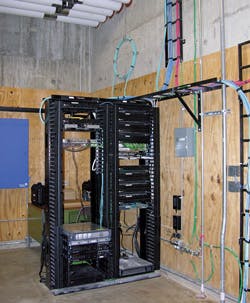Progressive technology on exhibit at iconic art museum
From the June, 2013 Issue of Cabling Installation & Maintenance Magazine
Category 6A and Category 7A cabling equip the St. Louis Art Museum for today and the future.
By Robert Carlson, The Siemon Company
Forest Park in the heart of St. Louis has hosted its share of events throughout its 137-year history, including the 1904 World's Fair and Summer Olympics. Now home to a variety of attractions like the St. Louis Zoo, Science Center and Missouri History Museum, this 1,371-acre public space recently hosted another event--the privately funded $130-million expansion of the iconic St. Louis Art Museum (SLAM).
Over the past 125 years, SLAM has acquired collections that place it among the ten most comprehensive art museums in the country. With more than half a million visitors each year viewing works from distinguished artists like Martisse, Van Gogh, Picasso, Monet and Gauguin, SLAM had outgrown its main building that was originally constructed for the 1904 World's Fair. SLAM's expansion includes a new 224,000-square-foot East Building that increases the museum's public space by more than 30 percent, expanded education facilities in the South Building, 300 additional parking spaces and a new fully accessible entrance.
Designed in keeping with the original 1904 structured by the independent firm Arup (www.arup.com), the expansion project also includes extensive improvements to the entire museum that address existing infrastructure deficiencies, including the network cabling infrastructure. While few can see the relationship between classic works of art and state-of-the-art networking, Jason Stockmann, SLAM's director of information technology, knew he needed the right cabling infrastructure solution to support the museum's technology objectives.
A new specification
When it came to designing the cabling infrastructure for the museum, Stockmann and the design engineering firm of William Tao & Associates (www.wmtao.com) felt the original Category 5e specification with a maximum 1-Gbit/sec transmission rate was a very "watered down" version of what would be required to support the museum's objective of a converged Internet Protocol (IP) network.
"While we never tell our clients what to use, if they are considering a technology that is on the way out, or if the applications being considered call for something else, we work with the client to suggest the right technology for their needs," says Janis Christopher, RCDD, telecommunications project engineer with William Tao & Associates. The firm also designed the lighting, audio/visual, sound, security, building-automation, fire-protection and plumbing systems for the project and provided Leadership in Energy and Environmental Design (LEED) design and management services.
In addition to voice and data, the museum wanted to deploy IP-based security, audio/visual, video, lighting, environmental controls, adjustable shades and parking-garage security with complete remote-control capabilities.
"We planned for museum lighting to be automatically controlled via servers on the network, as well as all environmental controls, like boilers and chillers," said Stockmann. "We have very strict temperature and humidity controls to protect the precious antiquities inside the building. The cabling infrastructure needed to be the foundation of the facility, while providing the capability to support technologies well into the future, which at some point will include free WiFi access for museum visitors."
As a believer in standards-based technology, Stockmann wanted a cabling solution that would serve as a strong backbone for all current and future networking capabilities that the museum required, even if they had not yet been identified. During the early planning stage for the museum expansion, Tony Campbell, regional sales manager for Siemon and an art enthusiast, developed a relationship with Stockmann and educated the museum's information technology (IT) department on network cabling infrastructure solutions capable of supporting their vision for the next 20 years.
"I sought to completely future-proof the process, and I knew that Siemon could help us do that," said Stockmann. "The goal was to eliminate the possibility of a substandard, high-cost, inefficient design that might require removal and replacement of the cabling infrastructure in the future as needs expanded."
Stockmann worked with William Tao and Siemon to upgrade the original specification to a Category 6A shielded solution able to support 10-Gbit/sec transmission. Working within the constraints of the project budget, Stockmann had to rally for implementation of the higher-performing solution and ensure careful planning and execution to stay within budget. He was able to highlight the higher long-term cost that the originally specified Category 5e solution would require, illustrating how a shielded solution supports multiple generations of networking applications and would not restrict the museum's ability to progress technologically.
"We didn't know exactly what applications and what type of art exhibits would be deployed at the museum, including the potential for electronic media exhibits that could potentially introduce interference," said Christopher. "With its superior resistance to EMI [electromagnetic interference] and RFI [radio-frequency interference], we felt that shielded cabling would give them the ultimate protection. Due to the architecture and having to deal with existing pathways and coffered ceilings, the size of the pathway was also a concern. The smaller diameter of the shielded cable was therefore another benefit to consider."
The right components
The museum was required to seek competitive bids and reviewing the various responses to the request for information (RFIs) proved challenging. "Some vendors tried to substitute lower-end solutions and substandard warranties, which we absolutely did not want," said Stockmann. "At the end of the day, Siemon provided not only competitive pricing and a carefully orchestrated specification and implementation, but also offered us a rock-solid warranty." Siemon provided SLAM with an end-to-end 20-year system warranty covering products, performance margins and applications assurance. Additional benefits included Siemon's comprehensive quality-control procedures and no outsourcing for manufacturing, which offered Buy American compliance.
To support voice, data, IP security and building- and environmental-control systems throughout the museum from 26 strategically placed telecommunications rooms (TRs), SLAM deployed a Siemon ConvergeIT solution consisting of a Z-Max Category 6A shielded end-to-end cabling system. Able to easily support 10-Gbit/sec transmission, Siemon's Z-Max 6A shielded system is independently tested and provides high margins over all TIA and ISO/IEC performance requirements for Category 6A, including critical alien-crosstalk parameters. The system consists of shielded Z-Max 6A outlets, Category 6A F/UTP cable, shielded Z-Max patch panels and shielded patch cords. Shielded Z-Max connecting hardware features a unique, patented printed circuit board (PCB)-based plug design that maintains pair symmetry and eliminates termination variability, and a punchdown connection that eliminates split and crossed pairs. Z-Max connectors also provide a termination time of less than one minute, automatically terminating the cable shield without additional steps.
For the renovated education center in the South Building, the museum implemented an even higher-performing solution--Siemon's TERA Category 7A fully shielded solution, which exceeds ISO/IEC Category 7A/Class FA specifications and provides a bandwidth of 1.2 GHz per pair, as well as cable-sharing capabilities. Cable sharing is the practice of running more than one application over different pairs of a twisted-pair copper cable. When using the TERA Category 7A connector that eliminates split pairs, up to four applications can be shared over a single cable. The TERA connector can accept a single four-pair cord, four one-pair cords, or two two-pair cords without the need for splitters or adapters, allowing various applications to be converged onto a single cable.
"In designing the new education center with its three classrooms and flexible open space, we considered the fact that the museum did not know exactly what type of technologies and applications would need to be supported by the connection--it could be a projector, video display, computer or phone," said Christopher. "We had the experience with the TERA Category 7A solution and cable sharing in our own facility, and we knew that the versatility of the system was a good match for this space. The dynamic interface of the TERA Category 7A system and its ability to support multiple applications over a single cable would allow the museum to use the connections for whatever they needed without having to add additional cables in the future."
Within the data center that connects to each of the museum's 26 TRs via 12 strands of Siemon XGLO laser-optimized 50-micron multimode fiber, fiber connections between switches are made with Siemon's Plug and Play system. This system features trunk cables that consist of Siemon's RazorCore 50-micron laser-optimized multimode fiber cable, factory-terminated to 12-fiber MTP brand connectors, thereby providing rapid installation and deployment. In keeping with SLAM's eye on the future, the MTP fiber trunks and connectors also support easy migration to future speeds of 40 and 100 Gbits/sec.
Two 12-fiber MTP trunks are connected to the rear of each Plug and Play module that breaks out to 24 Siemon duplex LC connections at the front of the module. Siemon's XLR8 prepolished mechanical-splice LC connectors were terminated using the XLR8 termination tool, which incorporates an exclusive dual-process activation that significantly reduces termination time. Within the museum data center, active and passive equipment is housed in Siemon's RS3 series cable management rack system that eases routing of cabling and patch cords, and includes covered vertical channels for a clean, professional look.
With the help of Siemon's technical support team, SLAM also deployed a fiber-to-the-desk application to the new information desk in the main hall. To preserve the original marble floor in this area, Siemon provided a surface-mount fiber solution using a customized flush-mount box under the marble tile that terminated MTP fiber in the floor. This allowed SLAM to maintain the plug-and-play MTP application and support future migration beyond 10 Gbits/sec.
Ready for tomorrow
In addition to enhancing the infrastructure of the century-old building, the expansion of SLAM creates a new gallery space for collections, and expands and improves visitor amenities. The additional gallery space has also given curators the opportunity to rethink the way the museum's world-class collections are installed.
The expansion also aimed to construct a building with a distinctive architectural character that complements the existing facilities, takes advantage of the museum's spectacular site in Forest Park and ensures environmental sustainability. The new East Building features a dark, polished concrete façade as well as new galleries and public spaces with skylights, and a number of floor-to-ceiling windows to provide views from both inside and outside. Upon completion, the museum received LEED Gold certification for the project, which helps support sustainability of the Forest Park area--all supported by a Siemon ConvergeIT cabling system using a single, simplified structured cabling infrastructure for a smarter, greener building.
"Being based here in St. Louis and having a lot of pride in the Forest Park area and its history, we were honored to be a part of the SLAM expansion project," said Christopher. "Having always been an icon on the hill, the museum is more spectacular than ever before."
The museum scheduled a June 29th opening with a grand celebration including a gala and ribbon-cutting ceremony, and Stockmann is confident the Siemon cabling infrastructure William Tao designed will support the museum's technology needs for many years to come. "This infrastructure gives us the capability to handle anything that comes our way for probably more than 25 years," he said. "Any limitations in bandwidth will be with the outside services coming to the building, not with the structured cabling inside."
Stockmann enjoyed working with Siemon, and ultimately had his IT team become Siemon Certified Installers to be able to install additional network locations and better maintain and manage the infrastructure, while maintaining the warranty. "From our very first conversation through today, the pride and enthusiasm that Siemon has had for this project is evident in every aspect," he said. "From identifying the appropriate solutions right down to the face plates and the training, working with Siemon was seamless. But cabling isn't just cabling--the people behind it make the difference, and Siemon definitely made a difference." ::
Robert Carlson is vice president of global marketing for The Siemon Company (www.siemon.com).
View Archived CIM Issues







